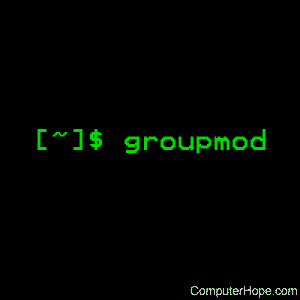Linux groupmod command

On Unix-like operating systems, the groupmod command modifies the configuration of a group.
This page describes the GNU/Linux version of groupmod.
Description
The groupmod command modifies the definition of the specified group by modifying the appropriate entry in the files /etc/group, /etc/gshadow, and /etc/passwd.
Syntax
groupmod [options] GROUP
Options
| -g, --gid GID | The group ID of the given GROUP is changed to GID. The value of GID must be a non-negative decimal integer. This value must be unique, unless the -o option is used. Users who use the group as primary group are updated to keep the group as their primary group. Any files with the old group ID and must continue to belong to GROUP, must have their group ID changed manually. No checks are performed with regard to the GID_MIN, GID_MAX, SYS_GID_MIN, or SYS_GID_MAX from /etc/login.defs. |
| -h, --help | Display help message and exit. |
| -n, --new-name NEW_GROUP |
The name of the group is changed from GROUP to NEW_GROUP. |
| -o, --non-unique | When used with the -g option, allow to change the group GID to a non-unique value. |
| -p, --password PASSWORD |
The encrypted password, as returned by crypt. Note: This option is not recommended because the password (or encrypted password) is visible by users listing the processes. Make sure the password respects the system's password policy. |
| -R, --root CHROOT_DIR |
Apply changes in the CHROOT_DIR directory and use the configuration files from the CHROOT_DIR directory. See also chroot. |
Configuration
The following configuration variables in /etc/login.defs change the behavior of this tool:
MAX_MEMBERS_PER_GROUP (number)
Maximum members per group entry. When the maximum is reached, a new group entry (line) is started in /etc/group (with the same name, same password, and same GID).
The default value is 0, meaning there are no limits in the number of members in a group.
This feature (split group) permits to limit the length of lines in the group file. This is useful to make sure lines for NIS groups are not larger than 1024 characters.
If you need to enforce such limit, you can use 25.
Split groups may not be supported by all tools (even in the Shadow toolsuite). You should not use this variable unless you need it.
Exit values
The groupmod command exits with the following values:
| 0 | Success. |
| 2 | Invalid command syntax. |
| 3 | Invalid argument to option. |
| 4 | Specified group doesn't exist. |
| 6 | Specified group doesn't exist. |
| 9 | Group name already in use. |
| 10 | Can't update group file. |
Examples
For this command to work, you must have superuser rights or be logged in as root.
groupmod -n bettergroup newgroup
In the example above, the groupmod command would change the group "newgroup" to "bettergroup".
Related commands
gpasswd — Administer /etc/group and /etc/gshadow.
groupadd — Add a group to the system.
groupdel — Remove a group from the system.
